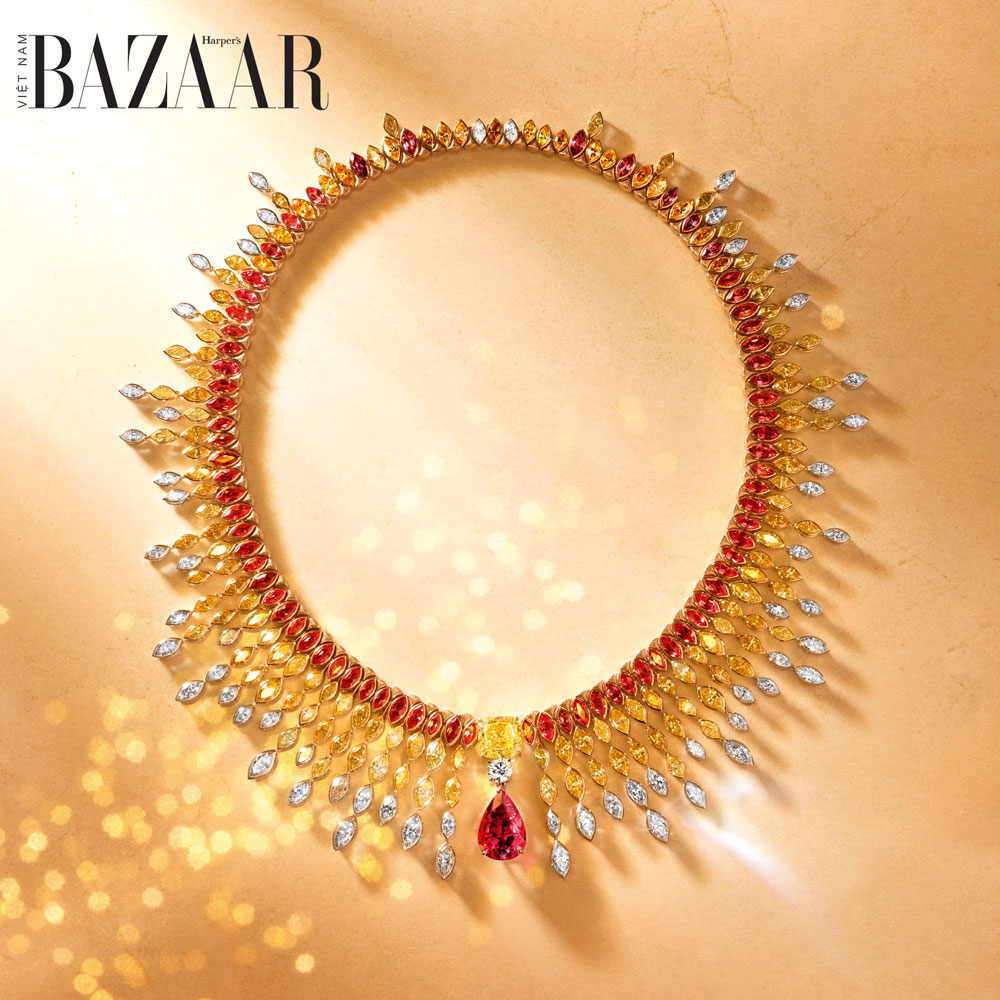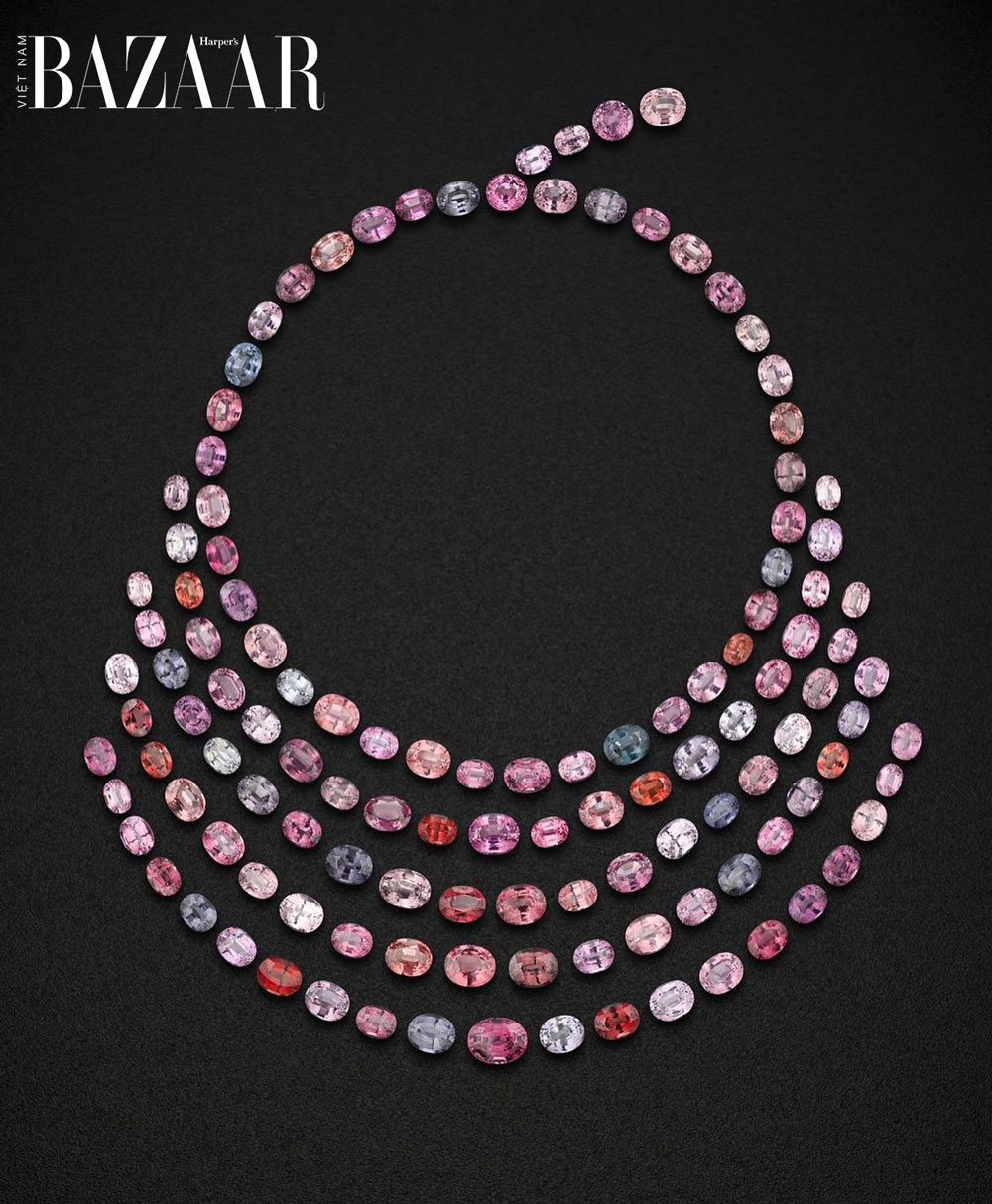
Blazing Sky necklace with East African carat spinel and Paraiba tourmaline, from the Sunlight Escape High Jewelry collection, Piaget
To understand red spinel and its history, it is essential to know the significance attributed to ruby; ruby is by far the most precious colored gemstone, and in the past, any red gem was measured by the standard of how close it resembles ruby. Thus, red spinel was the best substitute for ruby, but with a major advantage, spinel tends to form much larger crystals.
ABOUT THE AUTHOR: ROLAND SCHLUESSELRoland Schluessel was born in Switzerland and spent part of his childhood in Milan, Italy. After graduating from business, management, and marketing schools in Switzerland, he studied gemology in Germany and London, Great Britian, where he was awarded the Rayner Prize in 1985. During his numerous travels to the gemstone centers and mining sites in South America, Africa, Europe and Asia, Roland captured more than 200,000 pictures of gem mining, gemstones, and geological processes such as volcanic eruptions. Roland Schluessel resides in San Francisco. Together with his wife Nata, they own the gemstone wholesale company Pillar & Stone International specializing in fine colored gemstones and jadeite. Roland is also the author of a book about Rubies and Sapphires from Myanmar. |

The Sunlight Journey Spinel Necklace in 18K gold and platinum, set with 10.09 carats pear-shaped red spinel from Tanzania, Piaget
Spinel sparks royalty
Scarcity is one of the main drives for desirability of gemstones. Red spinels, formerly called “balas rubies”, tend to reach larger sizes than rubies, the former were particularly cherished by medieval European monarchs. The name “balas” is derived from the Sanskrit “balasuryaka” which translates as “crimson-colored morning sun”.
Most accounts in published literature and online narrate about a history of red spinel being confused with ruby. This might be true for European historians and antique dealers that had no expert knowledge about gemstones, as they were more interested in ascribing tales to the artworks they were selling.
However, this misconception did not run among the Muslim gemstone merchants that negotiated the precious red gems along the trade routes as early as the 11th century, and probably even sooner. They brought the “balas”, as red spinel was then called, from their original source high in the Pamir mountains of Badakhshan, now in Tajikistan, all the way to Spain. Granada was a Muslim stronghold from the 8th to early 13th century. Also, gem cutters were aware that the “balas” do not resist the abrasion of a cutting wheel as much as ruby does; they knew that a softer stone means a different gem species.
The chemical makeup of spinel was scientifically identified and differentiated from ruby in 1783.
A mix of history and tales

The famous Black Prince Ruby set in the cross pattée above the Cullinan II diamond at the front of the Imperial State Crown of the United Kingdom.
The most famous red spinels are the 170-ct Black Prince’s Ruby and the 352.50-ct Timur Ruby. Both gems share a similar blend of history and myths: both cannot be traced back to their purported owners, are of a particular large size, have a similar cutting style, and are in the inventory of the British Crown Jewels.
The Mughals that ruled over India and modern-day Pakistan from the 16th to mid-19th century had a great passion for exceptional gemstones and natural pearls. In 1739, when the Persians led by Nader Shah sacked Delhi, many great gemstones were taken as spoils of war, including the 500-carat Samarian Spinel, which is currently part of the Iranian National Jewels.
With the decline of the Mughal Empire came the loss of their treasures, and many “spinel-rubies” and Colombian emeralds, once sold to them by the Europeans, were headed back to the West, mainly to Paris, London, and even Saint Petersburg, where the Catherine the Great Ruby was integrated into the Peter the Great’s gem collection. The 386-carat spinel was set atop the Russian Imperial Crown that the empress commissioned for her coronation in 1762.

The Sunlight Journey Spinel Necklace in 18K gold and platinum, set with 10.09 carats pear-shaped red spinel from Tanzania, Piaget
The rediscovering of spinel
Not only does currently spinel experience a great comeback, but also some artistic jewelry-making techniques developed by Mughal craftsmen in Delhi and Jaipur, are revived in contemporary jewelry-making.
It was not at the “lost and found” office that the nearly forgotten “classic gem” was rediscovered. What made possible the remarkable revival of spinel, was the sudden availability of spinel in all shades of red, ranging from pink to deep purple, and blue, from light pastel blue to deep blue.

Necklace layout with 400 carats of Burmese spinels representative of the variety of colors mined in the Mogok Valley of Myanmar, Pillar & Stone International. Photo: Robert Weldon/ (c)GIA
For many reasons, mainly geopolitical ones, Spinel was so scarce until the 1990’s that only top collectors and few museums had the privilege to possess a gemmy sample. The situation changed with the collapse of the Soviet Union in 1991, coinciding with a more systematic approach of gemstone prospection notably expanded to Africa and some parts of Asia.
Suddenly, red spinels from the Valley of Mogok, Myanmar (formerly Burma) and pinkish to purplish red spinels from Pamir in Tajikistan were available on the market. Both of these sources did not produce, or at least did not export spinel for most part of the 20th century.

La Cavaliere diamond and red spinel set from Riders of the Knights high jewelry collection, Louis Vuitton
In Myanmar, it was recognized that the formation of red spinel is linked to the marble-related ruby deposits. During metamorphic processes, the growing red spinel crystals consumed the magnesium present in marble, thus, creating ideal conditions for the chemistry of ruby. Both gems owe their spectacular red to traces of chromium. To the discovery of ruby in northern Vietnam followed a commercial production of Vietnamese spinels, first pink to red, followed by bright blue.

Gold and platinum bracelet featuring central cushion-cut blue spinel, sapphires and diamonds, from the 2015 Blue Book high jewelry collection, Tiffany & Co
What definitely brought spinel to the attention of a broader public was the spectacular 2007 discovery of bright red spinel in Tanzania. Within a few weeks, Mahenge changed from an unknown farmland to the foremost producer of gemmy spinel. It is the exceptional combination of high transparency, strong brilliancy, and vibrancy of color that makes fine spinel the darling of gem merchants and collectors.
Ideally, spinels from Mogok can display a more characteristic ruby color, but they are remarkably rare in sizes exceeding 3 ct. Mahenge spinels excel in brightness. Pamir spinels are available in larger sizes, but their pink to red hues usually show a purplish secondary color.
Even though the physical properties of spinel are considered inferior to those of ruby, one advantage is that, unlike corundum, spinel exhibits the same pure color in all directions. Also, red spinel reaches its ideal color at a lower level of saturation than ruby, which contributes to a higher brightness in spinel. This also applies to blue spinel compared to blue sapphire.
Pink to pinkish red Burmese spinels with a strong red fluorescence have such a strong glow, that they are sometimes called “Jedi Spinels”, referring to the lightsaber from the Star Wars movie series. The rarely occur in sizes over 1.50 ct when cut but are extremely thought after because the fluorescence supercharges the red and produces an “electric” brightness.

Imperial Spinel necklace from BVLGARI Magnifica High Jewelry collection, featuring the 4th largest known spinel in the world weighing 131.21 carats, Bulgari
A pure red spinel exceeding 5 carats is one of the most exceptional gems: particularly considering the near depletion of the mines in Myanmar and Tanzania. Like a Mogok ruby, a Burmese spinel is negotiated with a premium. It is expected that high-quality spinel will be as rare in the near future as it was for centuries past. Seize the period, as time does not wait for anyone! If you cannot afford a red spinel, choose a pink one, as it can nearly rival with a fancy colored pink diamond when ideally cut.
RED SPINELFamily: Spinel. Color: Red and all saturations from pink to dark purple. Most important quality parameter: Beauty of color. Significant value parameter: Purity of color. Pleochroism: None. Most prestigious color: Vibrant pure red. Fluorescence: Red to pink spinel show red fluorescence. Transparency: Transparent. Ideal cut: Faceted square cushion or rectangular cushion. Other popular cuts and shapes: Oval, pear shape, heart shape, round. Hardness: 8 Clarity: Well-saturated red spinel tends to be more included than lighter or darker ones. Toughness: Good. Optical effects: Asterism is more common in blue than in red spinel. Treatments: Rarely heated. Stones with surface-reaching fissures, particularly cabochons, are occasionally oiled, or polymer impregnated. Red spinel lookalikes: Ruby, rubellite, red garnet. Main imitations: Synthetic spinel, assembled stones, glass. Birthstone: August. Price/value for finest quality red spinel on a scale from 1 (lowest) to 10 (highest): 8 |

Ring with “electric blue” spinel and rutilated quartz, Hamana Group
Bright blue from Vietnam
Blue spinels were traditionally available from Sri Lanka, and darker blue gems were later discovered in Australia and East Africa, where they often share a common source with dark blue sapphire.
It was around the turning of the millennia that bright blue cobalt spinel was discovered in the Luc Yen region of northern Vietnam. Traces of cobalt and some iron contribution generate all levels of blue saturation, from very light to vivid. These mind-blowing new spinels of exceptional brightness were compared to “electric” blue Paraiba tourmalines from Brazil, so that once you have seen them, you will never forget them! Regrettably, they are so rare that most specimens are below the half-carat range. Strongly included material is sometimes available, but be cautious, their surface-reaching inclusions are often filled with polymer.
WHERE TO SHOP: SHREVE & CO Rings, earrings and necklaces with spinel and diamond set in platinum, Shreve & Co Established in 1852, Shreve & Co. is the oldest retailer in the state of California with locations in downtown San Francisco and Stanford Shopping Center in Palo Alto. As curators of modern luxury, we are committed to providing an exceptional shopping experience while always creating an opportunity for discovery. Each glance throughout our stores exposes a refined array of handcrafted jewelry and timepieces – a chance to reveal the new and different to those who appreciate the world’s most beautiful things. Shreve & Co. is proud to be home to Rolex, Patek Philippe, Panerai, Tudor, IWC, Vacheron Constantin, A. Lange & Sohne, Hearts on Fire, Harry Kotlar, Mikimoto and many more. To discover more from Shreve & Co., Tony Gross can help begin your journey. Please email tgross@Shreve.com to get started. Or, you can visit the official website shreve.com. |
Harper’s Bazaar Vietnam





